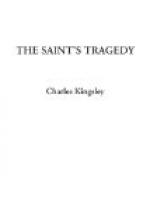P 136. ‘That she dared not.’ Cf. Lib. VII. section 4. ’When her most intimate friends, Isentrudis and Guta (whom another account describes as in great poverty), ’came to see her, she dared not give them anything even for food, nor, without special licence, salute them.’
P 137. ‘To bear within us.’ ’Seeing in the church of certain monks who “professed poverty” images sumptuously gilt, she said to about twenty four of them, “You had better to have spent this money on your own food and clothes, for we ought to have the reality of these images written in our hearts.” And if any one mentioned a beautiful image before her she used to say, ’I have no need of such an image. I carry the thing itself in my bosom."’
Ibid. ‘Even on her bed.’ Cf. Lib. VI sections 5, 6.
P 139. ‘My mother rose.’ Cf. Lib. VI section 8. ’Her mother, who had been long ago’ (when Elizabeth was nine years old) ’miserably slain by the Hungarians, appeared to her in her dreams upon her knees, and said, “My beloved child! pray for the agonies which I suffer; for thou canst.” Elizabeth waking, prayed earnestly, and falling asleep again, her mother appeared to her and told her that she was freed, and that Elizabeth’s prayers would hereafter benefit all who invoked her.’ Of the causes of her mother’s murder the less that is said the better, but the prudent letter which the Bishop of Gran sent back when asked to join in the conspiracy against her is worthy notice. ’Reginam occidere nolite timere bonum est. Si omnes consentiunt ego non contradico.’ To be read as a full consent, or as a flat refusal, according to the success of the plot.
P. 140. ‘Any living soul.’ Dietrich has much on this point, headed, ’How Master Conrad exercised Saint Elizabeth in the breaking of her own will. . . . And at last forbad her entirely to give alms; whereon she employed herself in washing lepers and other infirm folk. In the meantime she was languishing, and inwardly tortured with emotions of compassion.’
I may here say that in representing Elizabeth’s early death as accelerated by a ‘broken heart’ I have, I believe, told the truth, though I find no hint of anything of the kind in Dietrich. The religious public of a petty town in the thirteenth century round the deathbed of a royal saint would of course treasure up most carefully all incidents connected with her latter days; but they would hardly record sentiments or expressions which might seem to their notions to derogate in anyway from her saintship. Dietrich, too, looking at the subject as a monk and not as a man, would consider it just as much his duty to make her death-scene rapturous as to make both her life and her tomb miraculous. I have composed these last scenes in the belief that Elizabeth and all her compeers will be recognised as real saints, in proportion as they are felt to have been real men and women.
P. 142. ‘Eructate sweet doctrine.’ The expressions are Dietrich’s own.




